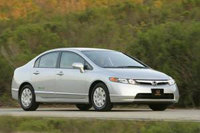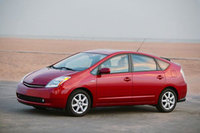Great to get around with, but cars can make you and your kids ill.
Story by Mallika Naguran

Beat the traffic and live healthier with pedal powerPetrol prices have soared to giddying heights. The cost of crude oil cracked US$100 a barrel and experts predict that the price can go nowhere but higher as global demand exceeds supply. Funny, this is what triggered non-stop calls from frustrated drivers ringing the Singapore Environment Council demanding more information on alternative powered motor vehicles.
Drivers reacted when their pockets were hit. From an environmental standpoint, that’s good news. Perhaps people will drive less, or give up their cars. Apart from a knee jerk response to market dynamics, people should realise the consequence of driving to the environment, their health and their children’s quality of living.

Greenest car Honda Civic GX runs on compressed natural gas which is unfortunately not widely availableOutside Pollution
Cars are a health risk but not many are aware just how bad they are. Consider pollution alone: the exhaust fumes from motor vehicles contribute to the third largest source of carbon dioxide emissions in the UK. In Europe, three times as many people die from breathing in traffic fumes as in road accidents. Healthy kids are three to four times more likely to develop asthma. In Sweden, a study by the Environmental Medicine in Stockholm found people exposed to heavy traffic pollution over 30 years had a 40% chance of developing lung cancer.
Even with leaded petrol being banned in most countries, the smoke emitted contains a lethal cocktail of carbon dioxide, carbon monoxide, cadmium, nitrogen oxides, benzene, sulphur dioxide and particulates – minute particles of matter – that ruin health. Nitrogen oxides are respiratory tract irritants, causing emphysema, a chronic obstructive lung disease. Benzene, accounting for 5% of a car’s output, is a known cause of leukaemia. Estimates have suggested that particulates are responsible for up to 10,000 premature deaths per year in the UK.

Hybrid 2007 Toyota Prius earns second spot in green ratingsIt is no wonder that in the UK, a fifth of lung cancer deaths in the cities are caused by polluting particles, mainly from vehicle exhausts.
If pollution doesn’t kill, car crashes may. Every day in the US, an average of 120 people are killed in car accidents. Car crashes are also the top killers of children in the US and in other countries.
Inside Pollution
Manufacturing cars require a whole of materials such as iron, steel, aluminium, zinc, lead, copper, platinum and plastics. Processing these materials is energy intensive, leading to harmful wastes and emissions. Environmentalists say an average 27 tons of waste are produced from the extraction of raw materials to make one new car.
It may surprise but car interiors produce toxins at high levels too. Interior plastics leech an ammonia gas that has been linked with foetal abnormalities, so pregnant women in the US are advised to drive with their car windows open.
The leather and treated textiles used in cars can emit up to 60,000 different allergens, something car makers forget to tell us about. Now, that’s a whole lot of health risks to go on a long drive with.
How to become a Green Driver:
• Switch to ultra-low sulphur petrol which produces 45% less nitrogen oxide and has lower benzene content.
• Fit a fuel saver in your fuel line to cut emissions by 40%, with fuel cost savings of 10%.
• Walk, cycle, rollerblade or take public transportation to work or shop. Studies show that a 10% increase in people walking regularly leads to 4% reduction in the number of people suffering from heart diseases. Plus if you cycle regularly, your body takes on a physique of those ten years younger. I think that’s enough incentive to convert to pedal power, don’t you?
• Convert to hybrid or electric cars. Hybrid cars (run on petrol and electricity) produce 75% less pollution than standard ultra-low emission vehicles. The Environmental Transport Association www.eta.co.uk has a guide of various models. Get nearly zero emissions from driving electric cars. You can even convert your existing petrol powered vehicle to electric. Learn more from visiting Electric Car Association www.avt.uk.com.
Greenest Vehicles 2008 according to the American Council for Energy-Efficient Economy. Rev to www.greenercars.org for details.
Honda Civic GX, which runs on compressed natural gas (CNG), was picked the greenest car for five consecutive years. Toyota Prius and Honda Civic Hybrid take spots two and three, while Smart Fortwo Convertible and Toyota Yarris round up top five green vehicles. The rest: Nissan Altima Hybrid, Toyota Corolla, Mini Cooper, Ford Focus, Toyota Camry Hybrid, Honda Civic and Honda Fit.